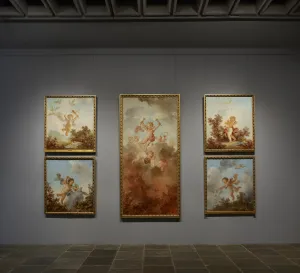Mapping Provenance: Fragonard's Progress of Love
December 23, 2021
By Christopher Snow Hopkins, Associate Editor
The Progress of Love Travel Itinerary
Origin (First Campaign): Louveciennes, France
Origin (Second Campaign): Grasse, France
Destination: Frick Madison, with stops in Paris, London, and 1 East 70th Street
Duration: 1771–72 and ca. 1790–91 to the present
Distance: at least 4,500 miles
What happens to a work of art when it is rejected by its patron? As illustrated by the turbulent history of Jean-Honoré Fragonard’s Progress of Love series, the destiny of an artwork—its path through time and space—depends in large part on the taste and temperament of the client who commissioned it.
Comprised of fourteen pictures, Fragonard’s Progress of Love was painted during two campaigns: one in the twilight of the Ancien Régime, and one just after the onset of the French Revolution. As Xavier F. Salomon, Deputy Director and Peter Jay Sharp Chief Curator, explains in the latest volume of the Frick Diptych series, the four principal scenes—in which a tenacious suitor courts a prospective match and ultimately wins her favor—were made in 1771–72 for Madame du Barry, the last mistress of Louis XV. This was a perilous moment for the French monarchy: republican sentiment was on the rise and with it the à la grecque style, a classicizing idiom at odds with the bosky frolics making up Fragonard’s Rococo series. Du Barry ultimately rejected the canvases, and they were kept in storage—likely rolled up in Fragonard’s lodgings at the Louvre—for the next twenty years.
But that is only the beginning of the story. Having fallen out of favor with his royal benefactor and with the public at large, Fragonard eventually found himself at a Provençal villa belonging to his cousin. In about 1790–91—one year after the Storming of the Bastille—The Progress of Love was installed in the main salon of the villa alongside ten new canvases created for the space. In the ensuing years, the fourteen-picture ensemble was acquired by a Gilded Age tycoon, shipped to the U.S. aboard the SS Olympia, acquired by a second Gilded Age tycoon, and most recently installed on the fourth floor of Frick Madison, where it can be seen today.
Mapping the Journey
Trace the twists and turns of the ensemble’s journey by navigating the interactive map below and read on to discover how the canvases, once scorned by a royal mistress, ended up at the Frick.
Use the icon in the upper-left corner to access all the individual stops in the journey or open the fullscreen map.
-
Louveciennes, France (1771–72)
At the direction of Madame du Barry and her architect, Claude-Nicolas Ledoux, Jean-Honoré Fragonard executes a cycle of four canvases—The Pursuit, The Meeting, The Lover Crowned, and Love Letters—for a music pavilion on the grounds of Du Barry’s chateau in the village of Louveciennes, about ten miles west of Paris.
-
Louvre Palace, Paris (1773)
The paintings are returned to the artist, who stores the canvases at the Louvre for the next twenty years.
-
Grasse, France (ca. 1790–91)
The four canvases are installed in Villa Maubert, a house belonging to Fragonard’s cousin in the Provençal town of Grasse, the artist’s birthplace. The architecture of the salon is modified to accommodate the cycle. To fill the remaining space, Fragonard creates an additional ten works, including a picture of a recumbent, daydreaming woman at the base of a column; a series of cupids in triumphant, playful, and murderous attitudes; and four narrow canvases depicting milky-blossomed hollyhocks. They remain at Villa Maubert for over a century.
-
Old Bond Street, London (1898)
The paintings are sold for 1,250,000 francs to the English dealer Charles Wertheimer. He then sells them to another dealer, Charles Morland Agnew, who exhibits them at his gallery on Old Bond Street.
-
Nos. 13–14 Princes Gate, London (1899)
On January 31, 1899, Agnew sells the ensemble to John Pierpont Morgan for £62,000. As there is no space to hang them at No. 13 Princes Gate, Morgan’s London residence, they remain in storage until April 1904, when the American financier buys the adjacent property. The canvases are exhibited in the front drawing room on the upper floor of No. 14. In a letter to the Boston collector Isabella Stewart Gardner, the art historian Bernard Berenson pays Morgan a backhanded compliment, praising his presentation of the Fragonards but remarking that the residence “looks like a pawnbroker’s shop for Croesuses.” In August 1912, the canvases are shipped to the U.S. on the SS Olympia. Morgan dies on March 31, 1913, and the series is loaned by his heir to The Metropolitan Museum of Art, where it is displayed beginning on February 18, 1914.
-
1 East 70th Street, New York City (1915)
In February 1915, the dealer Joseph Duveen acquires the ensemble for $1,250,000 and sells it to Henry Clay Frick at cost. In the spring of 1916, the paintings are hung at the Frick residence, transforming the Drawing Room into what is henceforth known as the Fragonard Room. The ensemble is reorganized to fit the room’s size and configuration, with three of the Hollyhocks relegated to storage. On May 22, 1916, twenty-five prominent New Yorkers gather for dinner at 1 East 70th Street to celebrate the installation. As Salomon reveals in his Diptych, they are served such delicacies as cold Virginia ham Strasbourgeoise and cheese straws.
-
Frick Madison (2021)
The three Hollyhocks in storage rejoin the fourteen-picture ensemble, on view as a complete suite for the first time in over a century in a new installation on the fourth floor of Frick Madison. Two adjoining galleries corresponding to the artist’s Louveciennes and Grasse campaigns reflect the series’s origins and the development of the artist’s style over a twenty-year period.

Photos by Joseph Coscia Jr.; map icons by Luciano Johnson, The Frick Collection

